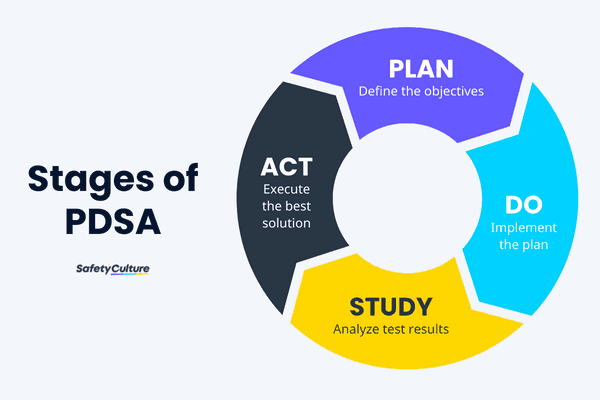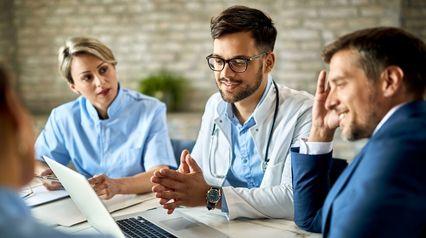What is a PDSA Template?
Following the concept of Plan-Do-Study-Act (PDSA) as a problem-solving and quality improvement method, a PDSA template is a tool used by organizations to streamline tasks, actions, and critical information when testing out an idea, concept, or suggestion by temporarily implementing a change in a process to analyze its impact and results. In most cases, the PDSA cycle is applied in the healthcare industry, but it can also be practiced in construction, retail, hospitality, and almost any setting or sector seeking to test ideas and improve strategic processes.
What is the difference between PDSA and PDCA?
Plan-Do-Check-Act, or PDCA, is the precursor of PDSA and was first introduced by Dr. Walter Andrew Shewhart in 1939. During the 1950s, though, it was further developed by Dr. William Edwards Deming with the aim of helping organizations implement continuous improvement efforts. The PDSA came to life when Dr. Deming revised the Shewhart cycle in 1993, incorporating the more comprehensive approach of “Study” compared to “Check.”
The most common difference between the two lies in each cycle’s third stage. PDCA uses “Check” while PDSA uses “Study.” PDCA allows organizations to focus on testing their current system and quality improvement processes, then use the “Check” stage to collect data and measure the results of the implemented change. PDSA, on the other hand, allows for a more in-depth analysis of the changes to be done. This is why it’s typically used by and within organizations in the healthcare industry.
Importance
With PDSA being a continuous improvement tool, an organization needs to establish an efficient system that opens up opportunities for change and growth to implement each of the cycle’s stages effectively. Since there can be a lot of tasks and processes involved in the overall cycle, using a PDSA template allows organizations to keep track of the set goals and objectives regarding the plan from the brainstorming phase up to its implementation or recommended next steps after the cycle. Also, using fillable forms helps make it easier to record the necessary details, actions, and resources during each stage of the process.
Stages of PDSA
PDSA has four stages: Plan-Do-Study-Act, each representing various questions to be answered and steps to be taken systematically. Since the PDSA cycle is an iterative process—meaning it should be done repeatedly based on review and testing—the steps under each stage can be modified depending on the results. Here, learn more about each stage and the connection between the four.
Pre-PDSA: Model for Improvement
Before performing the PDSA cycle, it’s important to use the Model for Improvement to help establish a more detailed approach to the change, idea, or solution being tested. This aims to let you define the primary gap that the PDSA cycle is trying to focus on.
These three questions for improvement must be answered before proceeding to the PDSA cycle:
- Aim – What are we trying to accomplish?
- Measures – How will we know that a change is an improvement?
- Opportunities – What change can we make that will result in an improvement?

Stages of PDSA
Stage 1: Plan
The Plan stage allows your team to define the objectives of the PDSA cycle, make predictions on the results, and explain why these results are expected to happen. Some guide questions to be used in this stage include the following:
- What change are we testing with the PDSA cycle?
- Who will be in charge of carrying out the plan?
- What are our predicted results?
- How long will it take for the change to be implemented?
- What data or information must be collected to tell if it’s an opportunity for improvement?
Stage 2: Do
Following up on the questions you answered in the first stage, the Do phase now focuses on implementing the plan or project and gathering key information. It’s important to document every kind of detail, such as experiences, issues, and discoveries that may arise during the test.
Stage 3: Study
Now, it’s time to look at the results from an in-depth perspective. The third stage is where you and your team members analyze or Study the test results and explore the details you’ve documented. Next, compare the results with the initial predictions you made during the Plan stage. Further, map out conclusions that best fit the gathered data.
Stage 4: Act
During the last phase, this is where you and your team can work on modifications and any other improvements needed to be done on the change before it’s fully implemented. Hence, this can also open up opportunities for succeeding PDSA cycles to be conducted.
The courses of action can be further categorized based on the nature of the test’s results:
- Adapt – The proposed change was good, but, as expected, improvement and continued testing are necessary.
- Adopt – The proposed change worked, so let’s proceed with the implementation planning.
- Abandon – The proposed change wasn’t remarkable, so we won’t push through with the implementation.
What Should be Included in a PDSA Template?
Here are the key pages and sections your PDSA template should include:
Introduction or Briefer
Start your PDSA template with a title page that includes the following details:
- Project Title (Idea/Solution Being Tested)
- Project Lead
- Start Date
- Expected End Date
Model for Improvement
Your PDSA template must also have a page dedicated to the 3 questions to be answered under the Model for Improvement. Text fields that can be used to input short or long-form answers are a simple yet straightforward approach for this.
Separate Pages for Each of the PDSA Stages
Four separate pages must be allotted for the Plan-Do-Study-Act stages. Doing this helps you organize the questions, details, and action items you need to accomplish in each stage.
Completion
Utilize the last page of the template to include closing details like:
- Notes
- Recommendations and Next Steps
- Sign-off
PDSA Template Example
Now that you’re aware of what a PDSA template is and its essential contents, here’s an example of what it looks like when using it in SafetyCulture:

PDSA Template Sample Report | SafetyCulture
FAQs About PDSA
As detailed in this guide, writing a PDSA follows this process:
- Answer the three questions under the Model for Improvement to set a proper context for the cycle.
- Proceed with the “Plan” stage to map out the steps needed in testing out the idea or solution.
- For the “Do” stage, carry out the test and document the analysis.
- “Study” the data gathered from the test and compare them with the predicted results.
- Lastly, “Act” lets you modify the change based on the learnings from the test and prepare the plan for the following tests.
The main purpose of conducting PDSA cycles is to improve current systems and innovate processes in an organization. Hence, PDSA is used as a tool for quality improvement. In fact, one of the main principles and methods of quality control called Lean uses PDSA as a technique.
As a rapid-cycle improvement strategy, a PDSA cycle typically lasts for a period of 3 months or less. As compared to other improvement methods that have a standard duration of at least 8 to 12 months, PDSAs aim to test out ideas and solutions that need immediate improvement through practicing in-depth analysis (hence the “Study” stage).
It’s crucial to ensure that the PDSA model is the best tool to use in your improvement efforts. While PDCA was further developed to create the PDSA model to cater to complex settings and solutions more effectively, the latter’s use still depends on the industry and the kind of improvement being tested to gauge its effectiveness.



